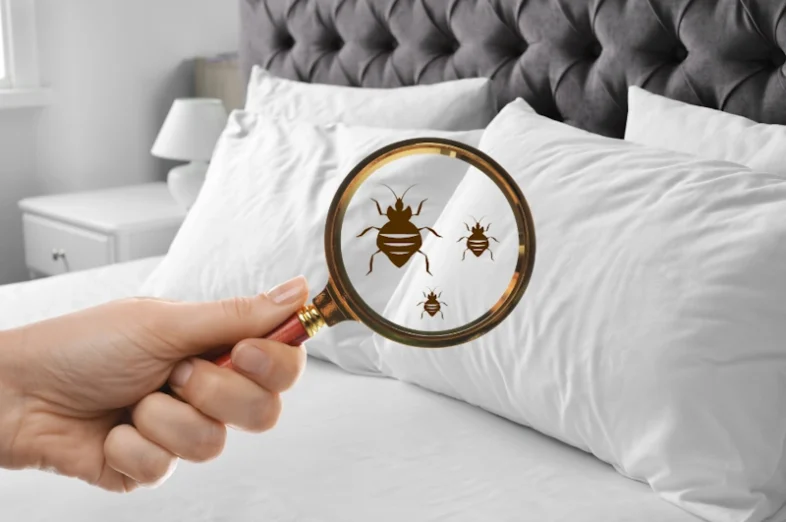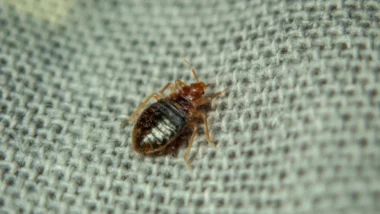How to check for bed bugs? Bed bugs are notorious pests that can infest homes, causing discomfort and potential health issues. These tiny, reddish-brown insects feed on the blood of humans and animals, primarily during the night. Detecting a bed bug infestation early is crucial for effective control and prevention. Today, we’ll explore the top ten signs of a bed bug infestation, helping you promptly identify and address the problem.
1. Unexplained Bites
How to check for bed bugs at home? One of the most distressing signs of a potential bed bug infestation is the emergence of unexplained bites on your body. Bed bugs are opportunistic feeders, and they usually target exposed areas such as the face, neck, arms, and hands during nocturnal feeding sessions.
These bites appear in distinctive patterns, often forming clusters or straight lines along the skin. The aftermath of bed bug bites can lead to redness, intense itching, and skin irritation, making the discomfort all too noticeable. If you wake up with these unexplained bites, it strongly indicates that bed bugs might share your sleeping space.
2. Visible Bed Bugs
How to check for bed bugs on beds and mattresses? The discovery of adult bed bugs is a definitive confirmation of an infestation. These tiny pests are characterized by their small, flat, and oval-shaped bodies, typically displaying a reddish-brown color.
The nocturnal nature of bed bugs makes them elusive during daylight hours, making their detection challenging. However, if you notice these insects on your mattress, bedding, or furniture, it indicates that a bed bug population has established itself in your living space. Swift action is crucial to prevent the infestation from worsening.
3. Tiny Bloodstains on Sheets
How to check for bed bugs if you see bloodstains on your bed? One of the more unsettling signs of a bed bug presence is the existence of tiny bloodstains on your sheets and pillowcases.
When bed bugs feed on their hosts, they leave behind small reddish-brown spots, which can be attributed to crushed bed bugs or their fecal matter.
These bloodstains are a significant red flag and should prompt a thorough inspection of your sleeping area and furniture. Identifying and addressing these stains promptly is essential to preventing the infestation from spreading further.
4. Dark Stains on Mattress and Furniture
How to check for bed bugs on other furniture? As bed bugs feed on blood, they excrete digested remnants, resulting in dark stains on various surfaces. Mattresses, box springs, and other pieces of furniture often bear the brunt of these excretions, showcasing small, dark spots.
It’s crucial to inspect these areas meticulously, especially along seams and crevices, as these dark stains are a clear indicator of a bed bug infestation. Regular checks of your bedding and furniture can help in early detection, enabling prompt intervention to control the infestation.
5. Musty Odor
How to check for bed bugs when there are other changes in the environment? In addition to physical evidence, a distinct, musty odor is another sign that bed bugs have infiltrated your living space. This olfactory cue is often described as sweet or offensive. If you detect an unusual smell in your bedroom or living area, it could indicate a significant bed bug infestation.
Bed bugs release this characteristic scent because their pheromones are more pronounced in areas where they aggregate or hide.
6. Eggshells and Shed Skins
How to check for bed bugs on the surface of beddings? Bed bugs undergo multiple life stages, each marked by the shedding of their exoskeletons. Detecting tiny, translucent eggshells and light brown exoskeletons is crucial in identifying a bed bug infestation. These discarded remnants, such as mattress seams, bed frames, and other furniture, can often be found where bed bugs hide.
7. Reddish-Brown Stains on Walls
How to check for bed bugs on walls? Bed bugs leave behind unmistakable evidence of their presence through reddish-brown fecal stains, and these may extend beyond bedding and furniture to include walls. Inspecting the areas around your bed, furniture, and electrical outlets is crucial for identifying these telltale signs.
The fecal stains result from digested blood excreted by the bed bugs after feeding.
8. Tiny White Eggs
A pivotal aspect of detecting a bed bug infestation is identifying their tiny, white eggs. These minuscule eggs are approximately the size of a pinhead, making them easily overlooked but crucial indicators of a burgeoning bed bug population. Bed bug eggs are typically laid in clusters, a strategy the insects employ to ensure a higher likelihood of survival for their offspring.
To uncover these hidden signs, it is essential to thoroughly inspect cracks, crevices, and other concealed spaces where bed bugs tend to deposit their eggs. Recognizing and promptly addressing these tiny white eggs is of utmost importance for early detection, allowing homeowners to take proactive measures to control the infestation before it escalates.
9. Rusty or Reddish-Brown Spots on Linens
How to check for bed bugs on linens? Another undeniable sign of a bed bug infestation is rusty or reddish-brown spots on bed linens. These stains are often the result of bed bug feces or crushed bugs, presenting a visible trail of the pests’ activity.
Regularly checking sheets, pillowcases, and other fabric surfaces is crucial for spotting these telltale signs.
These stains signify the immediate need for intervention but also aid in identifying areas where bed bugs may be concentrated. Thoroughly examining bedding and surrounding furniture can provide a comprehensive understanding of the extent of the infestation, allowing for a more targeted and effective eradication strategy.
10. Active During the Night
How to check for bed bugs at night? Bed bugs are predominantly nocturnal creatures, meaning they are most active at night when their hosts are asleep. Recognizing their activity patterns is vital in identifying a bed bug infestation.
If you observe small, crawling insects on your bed or furniture during the late hours, it clearly indicates that bed bugs have established a presence in your living space.
Monitoring and documenting their nocturnal activity can assist in pinpointing their hiding spots and devising a strategic control plan. Understanding the nighttime behavior of bed bugs is integral to the overall strategy for eliminating these pests and ensuring a peaceful, pest-free environment for residents.
Key Takeaways
Are you concerned about a potential bed bug infestation in your Mequon or Milwaukee home? Don’t let these pests disrupt your peace of mind.
Call Nexus Pest Solutions today at 414-355-3732.
Our experienced team is ready to provide swift and practical solutions to protect your home and family. Take the first step towards a bed bug-free environment – call us now for a thorough inspection and expert assistance. Your comfort and well-being are our top priorities.


